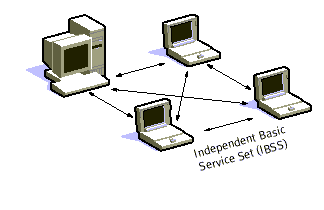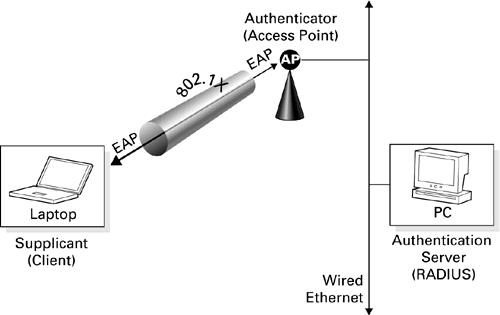
A wireless LAN or WLAN is a wireless local area network that use radio waves as its carrier: the last link with the users is wireless, to give a network connection to all users in the surrounding area. Areas may range from a single room to an entire campus. The backbone network usually uses cables, with one or more wireless access points connecting the wireless users to the wired network. Early development included industry-specific solutions and proprietary protocols, but at the end of the 1990s these were replaced by standards, primarily the various versions of IEEE 802.11 (Wi-Fi) and HomeRF (2 Mbit/s, intended for home use, unknown in the UK). An alternative 5 GHz standardized technology, HIPERLAN, has so far not succeeded in the market, and with the release of the faster 802.11 standards, almost certainly never will.
Wi-Fi is based on the IEEE 802.11 specifications. Currently deployed 802.11 variations are: 802.11a, 802.11b and 802.11g. The b specification was used in the first Wi-Fi products. The b and g variants are the ones most often sold as of today. There are also other 802.11 specifications, such as 802.11i (security for WLANs). On March 8, 2007 a single document was created, that merged 8 amendments (802.11a,b,d,e,g,h,i,j) with the base standard. The n variant is still the the Draft form and is expected to be ratified in October 2008. 802.11n builds upon previous 802.11 standards by adding Multiple-input/Miltiple-output technology, which uses multiple transmitter and receiver antennas to allow for increased data throughput.
| Specification | Speed | Frequency Band | Compatible with |
|---|---|---|---|
| 802.11b | 11 Mb/s | 2.4 GHz | b |
| 802.11a | 54 Mb/s | 5 GHz | a |
| 802.11g | 54 Mb/s | 2.4 GHz | b, g |
| 802.11n (draft) | 248 Mb/s | 2.4 or 5 GHz | b, g, n |
In most of the world, the frequencies used by Wi-Fi do not require user licenses from local regulators (e.g. the Federal Communications Commission in the U.S.). 802.11a equipment, using a higher frequency, has reduced range, all other things being equal.
The basic security used for a WLAN was originally Wired Equivalent Privacy (WEP), but this was shown to provide minimal security due to serious weaknesses. The alternate Wi-Fi Protected Access (WPA) security protocol was later created to address these problems. The second generation of the WPA security protocal (WPA2) is based on the final IEEE 802.11i amendment to the 802.11 standard. Software solutions such as SSL, SSH, and various types of software encryption have become the preferred methods of securing wireless information transmission.
There are two possible types of operation:
Peer-to-Peer/Ad-hoc mode

Infrastructure mode

IEEE 802.1x
